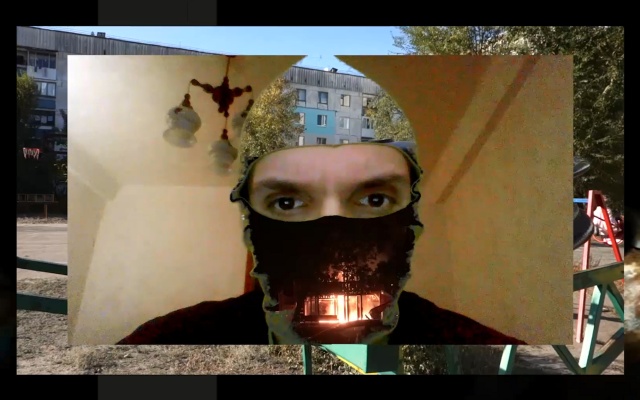Out of the many amateur videos, filmed in the war zone of Donbas and openly available online, there is a one that stands out in my memory. It shows Russian combatants torturing a local taxi driver, suspecting him of being involved in the drug trade. The victim is tied to a pillar in the yard of someone’s cottage – he can’t stand upright because of the whipping, his pants soiled with urine and his speech rendered to indistinguishable moans. As of today, the video has garnered over 300,000 views. “It is a violence done to the singular being, at the same time as to the image in its singularity.1 In the creation of reality even the most violent thing becomes illusory, and it makes the real meaning disappear,”2 – writes publicist Chris Baranyuk, following the footsteps of Jean Baudrillard. Is it possible to understand the loss of reality as the loss of compassion?
Shocking content on the internet is as common and popular today as pornography. People are drawn to forbidden and unattainable things that evoke powerful, yet primitive emotions. The threshold of these emotions is constantly rising, and that fact is exploited by people who publish and republish such content, making considerable money in the process. For a long time, violence has been a popular commodity in the consumption of visual information. A good example that comes from pop culture of the 2000s is slasher films, such as Hostel or Saw,3 which have grossed tens of millions of dollars. Although the documentary horrors of a real war are far more frightening, the viewer is still protected by the armor of the computer or smartphone screen. Yet how durable is the dividing line between the reality of what happens “to us” and “not to us”?
Right-wing video blogs of “activists” who hunt down people “suspected” of belonging to the LGBT community or national minorities had appeared in Russian and Ukrainian segments of the internet even before the outbreak of the war between the two countries. Since then, the “moral” values justifying immoral acts have become an important component of individual military groups and battalions. The toxicity of war makes one search for enemies where there are none. The logic of the “hostile environment” prompts a return to the cult of power and masculinity, in which any indication of diversity and otherness is regarded as a threat to “order.” Thus, critical art projects are also at risk. The Kyiv Visual Culture Research Center and other institutions were repeatedly attacked by right-wing radicals.4
In the need to defend themselves against the aggression of the Russian Federation, Ukrainians often ignore, and some of them even support the inadmissible actions of the right-wing activists. The strengthening of traditional values during the presidency of Petro Poroshenko came from the policy of “anti-propaganda” in the face of Russian aggression. But paradoxically, despite the originally declared “pro-European” course of the government that relied on freedom of expression and human rights, the anti-Russian propaganda had begun to reproduce the patterns of modern authoritarian Russia. As a result, much attention is paid to patriotic and militaristic education of children, both in schools and in special sport camps. In this context the problem of domestic violence, which largely affects women and children, remains virtually unnoticed.
Although young people consume information through social networks and blogs, a significant portion of the Ukrainian population still watches television. Movies in cinemas and online shows are presumed to be the content of entertainment and leisure, yet they have considerable political influence. A well-known producer and comedian Volodymyr Zelensky has constructed the image of “the People’s President” in his multimedia project Servant of the People – and in 2019 he was elected the President of Ukraine in real life. As the media define the public outlook more and more, the causal relationship between life on the street and life on screens is becoming closer and closer.
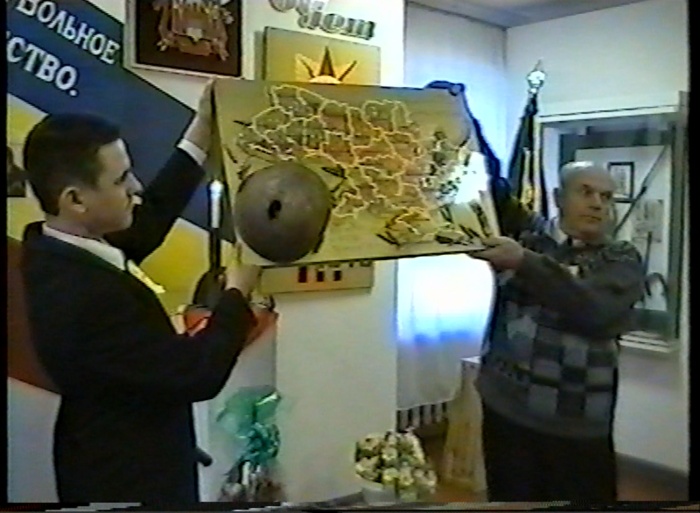
Ołeksij Radynski, Ceremoniały wojskowe, kadr z wideo, 2019.
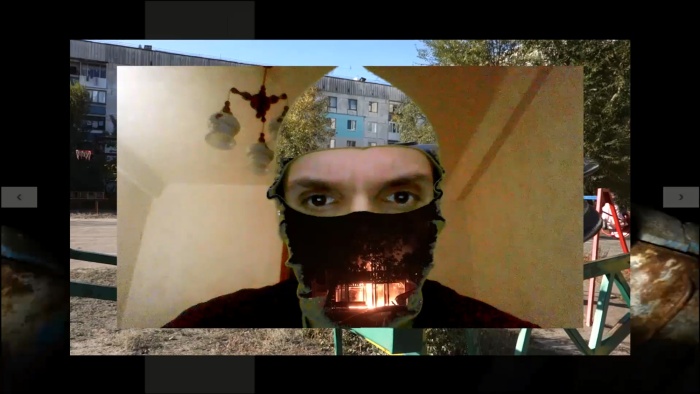
Pawło Chałjo, Struktury troski, kadr z wideo, 2018.
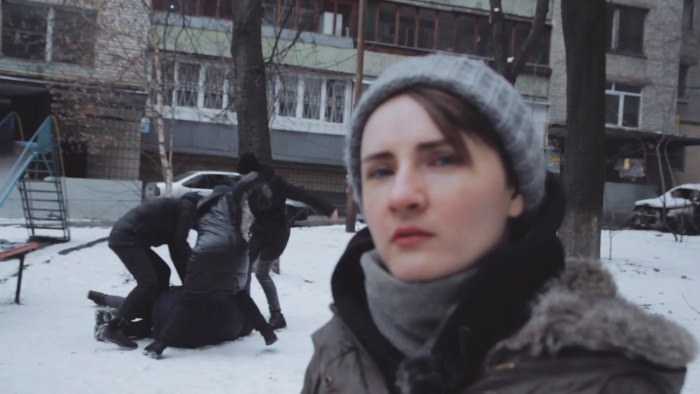
Anna Szczernyna, Wałentyna Petrowa, Siostry, kadr z wideo, 2019.
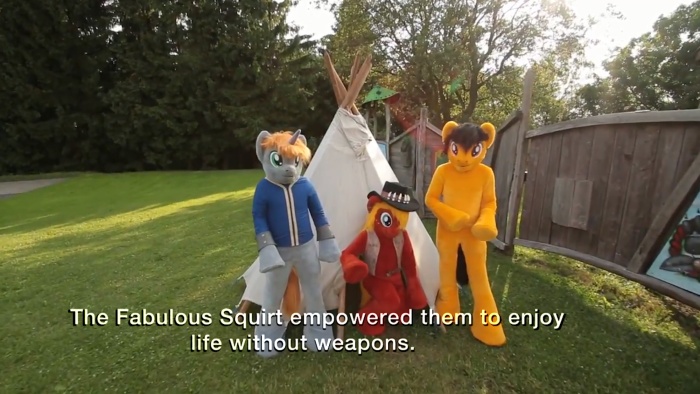
Oksana Kaźmina, Niezwykła Squirt, kadr z wideo, 2019.
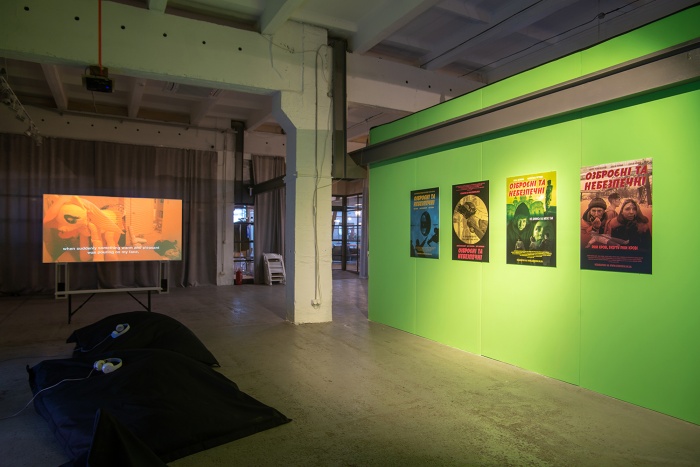
Uzbrojeni i niebezpieczni. Wystawa-serial. Widok instalacji z pracami Oksany Kaźminy i Daniiła Rewkowskiego, Platforma Inicjatyw Kulturalnych IZOLYATSIA, 2019. Zdjęcie: (c) Maksym Biloysov.
This type of context encourages artists to reflect through inter-media artistic expressions. This is how the Armed and Dangerous project came about. It started in 2017, when I made a series of videos as a critical reaction to the rising popularity of online commercial platforms such as Amazon Prime Video or Netflix.5 Created as a montage between staged scenes and documentary videos I had found online, the Armed and Dangerous series explored the problem of rising violence in Ukrainian society. Later, like-minded people joined the project and my role has since shifted to the curatorial. The result was an experimental series on the problems of militarization. The visual essays have been shown as video exhibitions, film almanacs, and online.6
One of the main questions I asked myself and the creators working on this project was how to talk about violence without reproducing and thus multiplying it? The first episodes of the series used an ironic approach to reenactment and cosplay. The characters reenact numerous viral videos, in which children play with weapons. Their actions seemingly complete the circle of the bloggers’ mimicking: the children mimic adults by playing with knives or grenades, and adult artists mimic the actions of these children. The game helps one to overcome fear and shock induced by reality.
Parody has become an artistic weapon in the works of Sasha Protyah, Oksana Kazmina, Anna Shcherbyna, Valentyna Petrova, and Alina Kleitman. Protyah and his friends try on the merchandise clothing of the Azov Battalion – a military formation that plays a large role in the life of Mariupol, a city they live in. The symbol of the battalion is reminiscent of the Nazi Wolfsangel, the battalion itself has many far-right members. The characters in the video play the roles of Azov members, uttering phrases inherent to right-wing radicals. This is done in a fairly senseless manner that turns the ideological pathos into laughter and absurdity.7
Imitating the form of journalistic coverage of the National Militia, Kazmina creates a “comic book story” about the Fabilous Squirt – a superhero who turns right-wing radicals into quirky characters of My Little Pony. Shcherbyna and Petrova play the members of a fictional organization entitled Sisterhood of St. Mary of Egypt, which parodies the name of the real anti-feminist group Sisterhood of St. Olga. Mixing suspense with documentary elements, the artists ridicule the cliché of what a woman should look like and behave according to the logic of the conservative women's movement. In The story of an Old Fat Girl: Notes on a Cruel and Evil Bull, Alina Kleitman transforms her own traumatic experience into a fairy tale and wraps it into the aesthetics of advertising. Her “notes” explores the theme of psychological abuse faced by a young person at family and at school.
The video-essays of Elias Parvulesco and Piotr Armianovski explore the topics of patriotic and military education, as well as the direct impact of the war on children. Parvulesco combines documentary footage from a firearms exhibition accompanied by an expert’s commentary with an act of a teenage girl walking with a gun in her hands. The children in the Armianovski’s film also hold pistols in their hands, playing “the war.” Interviews recorded in the liberated city of Slovyansk retell the version of the recent years’ events as they are taught to children at school.
Children’s war games in their current nationalist form, and their Soviet tradition have become the focus of Pavlo Hailo’s Structures of Care. Using a video of a popular children’s game Dzhura, found on YouTube, the artist reflects on his place as a researcher in front of a computer screen: an observer who becomes a participant, transmitting the material through himself. The Armed and Happy series created by the interdisciplinary art group Fantastic Little Splash “explores common emotional accents in virtual practices – from sports broadcasts to weapon exercises – in an effort to see how previously unacceptable behaviors are normalized through their collective spread in social media, how they become part of everyday life, contributing to further emotional contamination.”8
The start of the Armed and Dangerous project was preceded by a research trip to Stanytsia Luhanska – a settlement located on the border with the self-proclaimed LPR. A VHS archive was found at the Museum of Local History in Stanytsia, which recorded public events in the village 20 years ago. The most impressive among them was the recording of a recruitment ceremony to the Ukrainian army held in the tradition of the Russian Don Cossacks – it became the basis of the film by Oleksiy Radynsky, which is a montage of video archives. The artist states that the certain folklore vibe of the event “kind of encodes the militarism – and violence, in turn, is spread in the society, constrained within the frameworks allocated to it, but pouring out periodically.”9 Another essay, authored by Philip Sotnichenko, is also a montage of archival records – this one from the New Year celebration of the Russian community in Riga; it traces the presence of anxiety in festive rituals. The violence lurking in the tranquility of everyday life in Kyiv’s commuter districts is reflected in Stanislav Bytiutskyi’s film A Year After. Using the example of a firearm shooting that had left a schoolboy injured, the author speaks of the invisible violence near us, which we sometimes choose not to notice – like many problems that are displaced from the general consciousness.
“There is no way to separate, under present historical conditions, the material reality of war from those representational regimes through which it operates and which rationalize its own operation,” writes Judith Butler.10 Is Ukrainian society doomed to have war as a norm of everyday life and the idea of a perpetual war as an existential state? The normalization of the presence of violence makes it invisible to most members of society, which is certainly beneficial to those who commit it. At the same time, the project’s provocative (aimed at attracting attention) and analytical (aimed at conducting research) components are meant to acquaint and engage the viewer with the problem. In the situation when war and violence have become a necessary condition of existence, Armed and Dangerous uses weapons of emancipation to show that these concepts are not the only possibility and not without an alternative.
Translated from Ukrainian by Oles Petik
BIO
Mykola Ridnyi (born 1985 in Kharkiv) is an artist and filmmaker. He graduated in 2008 from the National Academy of Design and Arts in Kharkiv, where he got his MA degree in the sculpture department. Since 2005, he has been a founding member of the SOSka group, an art collective based in Kharkiv. The same year he co-founded the SOSka gallery-lab, an artist-run-space in an abandoned house in the center of Kharkiv. He curated a number of international exhibitions in Ukraine, among them After the Victory (CCA Yermilov Centre, Kharkiv, 2014), New History (Kharkiv Museum of Art, 2009) and others. Since 2017, Ridnyi has been the co-editor of Prostory – an online magazine about visual art, literature and society. Ridnyi works across media ranging from early collective actions in public space to the amalgam of site-specific installations and sculpture, photography and moving image, which constitute the current focus of his practice. His works are in the permanent public collections of Pinakothek der Moderne in Munich, Neuer Berliner Kunstverein, Ludwig Museum in Budapest, Museum of Modern Art in Warsaw, Arsenal City Gallery in Bialystok, V-A-C foundation in Moscow and others. Currently he lives and works in Kyiv, Ukraine.
*Cover photo: Pavel Khailo, Structures of Care, still from the video, 2018.
[1] Jean Baudrillard, Violence Done to the Image from The Intelligence of Evil, translated by Chris Turner.
[2] Andreas Treski, Теорія відео [Theory of video], Kharkiv: Center of Humanities, 2017
[3] Saw’s aesthetics and title (the first movie of the series published in 2003) have been used by an anonymous organization in Russia that created “The Saw List” in 2019, calling for the murder of LGBT activists.
[4] Visual Culture Research Center (VCRC) is an independent cultural institution in Kyiv, established in 2008 as a platform for interaction between academic, artistic and activist communities. The VCRC has been repeatedly raided by far-right activists: examples include the 2012 exhibition My Room by Yevgenia Belorusets and the 2017 exhibition Lost opportunity by David Chichkan. Vasyl Cherepanin, head of the VCRC, was attacked in the street in 2014.
[5] In 2017, Netflix licensed the Servant of the People show by Volodymyr Zelensky.
[6] In 2019, the exhibition series Armed and Dangerous was presented at the Isolation Platform for Culture Initiatives in Kyiv and the Yermilov Center in Kharkiv, and shown as a cinema almanac at the 48th Kyiv International Film Festival ‘Molodist’; some episodes of the series are available online at www.ozbroeni.in.ua.
[7] Hetmanova Dariya, Повторювати критично [Repeating Critically], Moscow Art Magazine, 2019.
[8] Malchenko Valeria, Емоційна наруга [Emotional Abuse], https://zaborona.com/ozbroieni-ta-nebezpechni-emotsijna-naruha/.
[9] Radynsky Olexiy, Військові ритуали [Rituals of War], 2019, https://zaborona.com/ozbroieni-i-nebezpechni-vijskovi-rytualy-kolonka-oleksiia-radynskoho/.
[10] Judith Butler, Frames of War, Verso, 2009.



